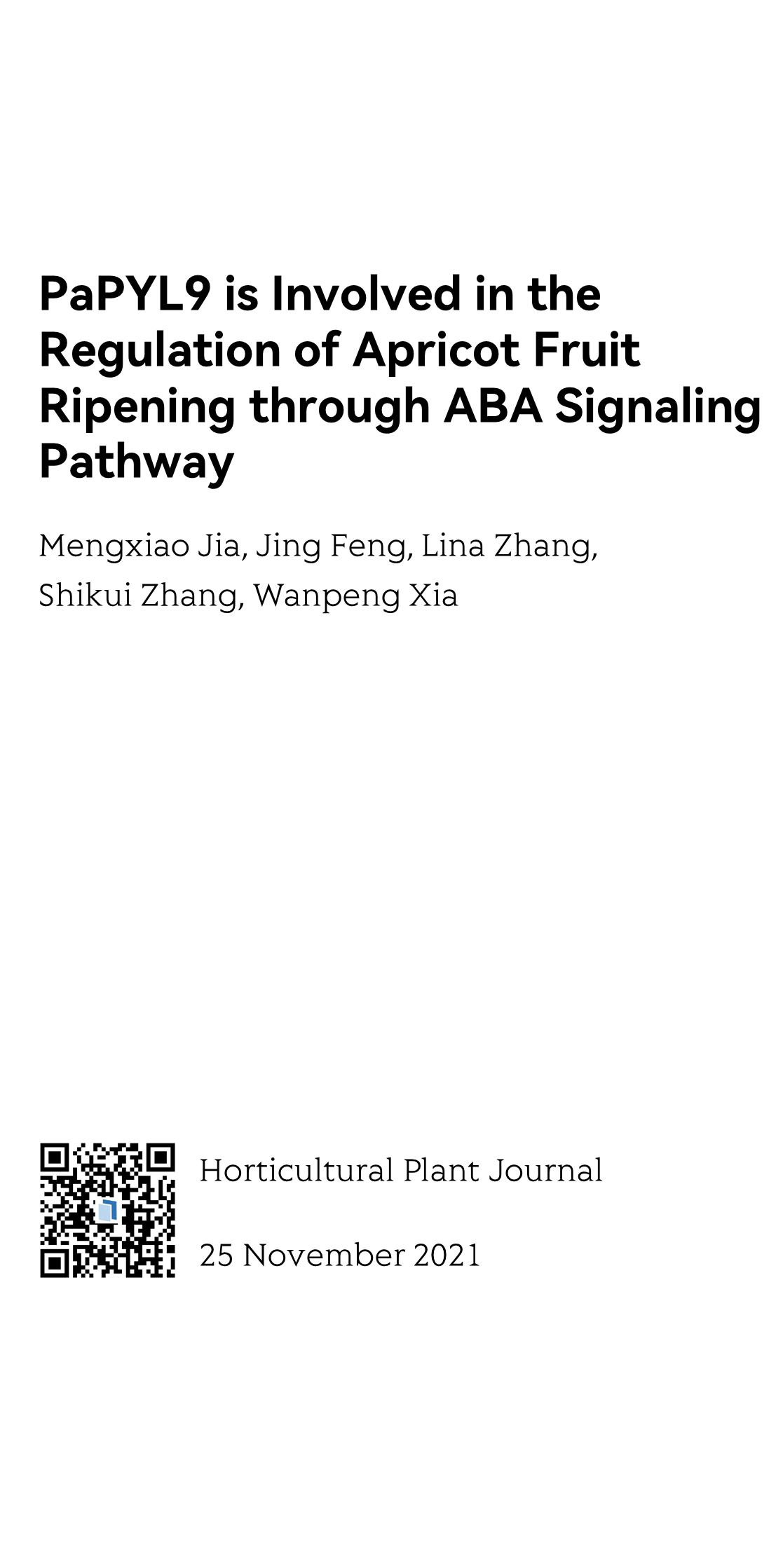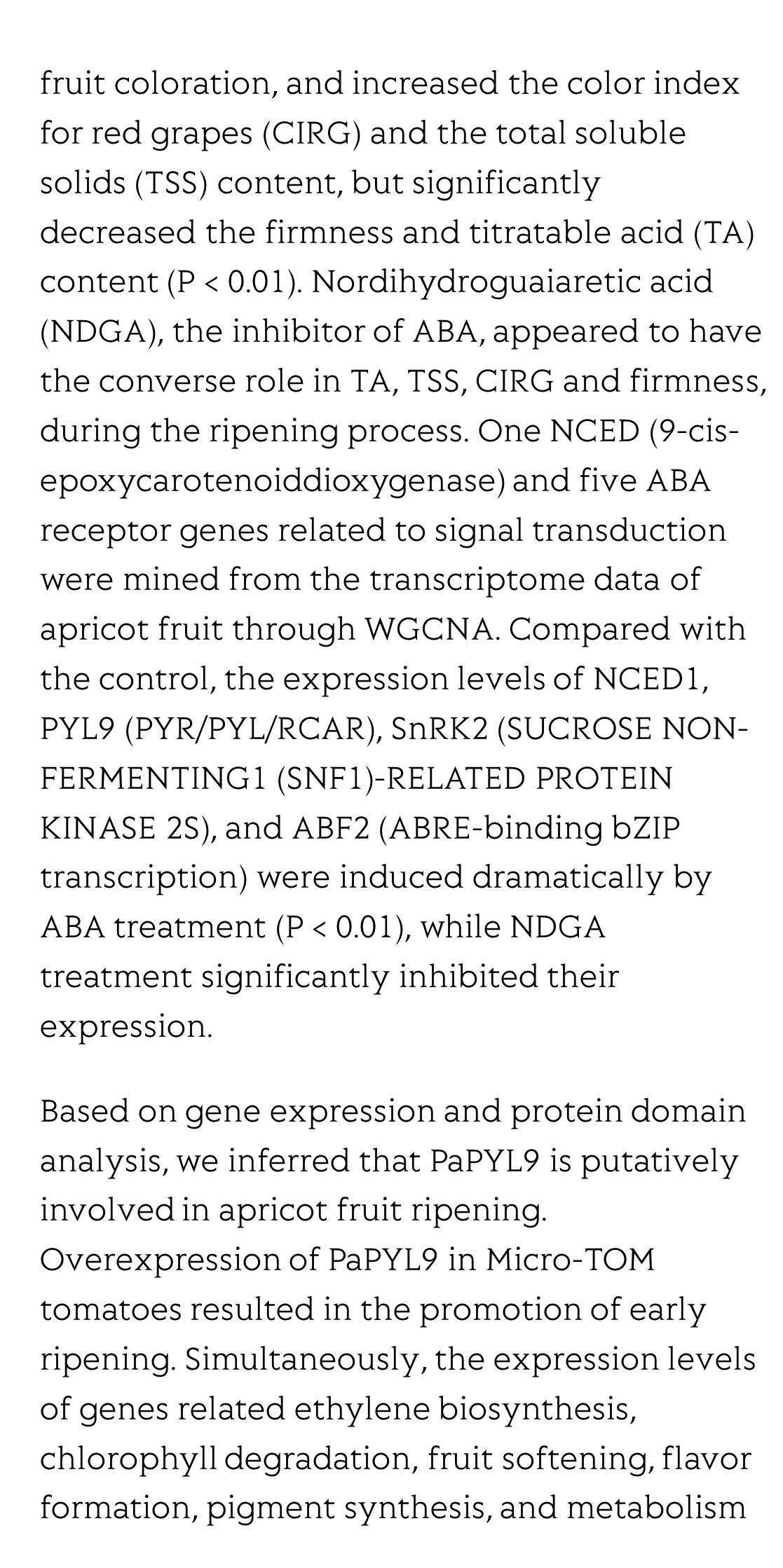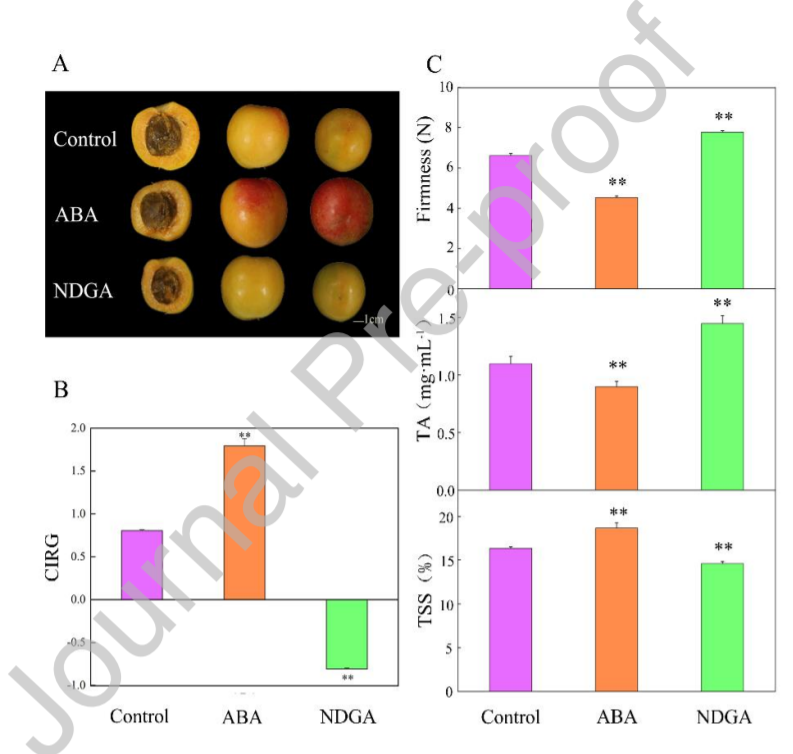(Peer-Reviewed) PaPYL9 is Involved in the Regulation of Apricot Fruit Ripening through ABA Signaling Pathway
Mengxiao Jia ¹, Jing Feng 冯靖 ¹, Lina Zhang ¹, Shikui Zhang 章世奎 ², Wanpeng Xi 席万鹏 ¹ ³
¹ College of Horticulture and Landscape Architecture, Southwest University, Chongqing 400716, China
中国 重庆 西南大学园艺园林学院
² Agriculture National Fruit Tree Germplasm Repository, Xinjiang Academy of Agricultural Sciences, Luntai, Xinjiang 841600, China
中国 新疆 轮台 新疆农业科学院 国家果树资源圃
³ Key Laboratory of Horticulture Science for Southern Mountainous Regions, Ministry of Education, Chongqing 400715, China
中国 重庆 南方山地园艺学教育部重点实验室
Abstract
Abscisic acid (ABA) is a major regulator of non-climacteric fruit ripening; however, the role of ABA in the ripening of climacteric fruit is not clear. Here, as a typical climacteric fruit, apricots were used to investigate the role of ABA in fruit ripening.
Based on weighted gene co-expression network analysis (WGCNA) of our previous transcriptome data, we treated 'Danxing' fruit with exogenous ABA and obtained ABA receptor genes, genes related to ABA biosynthesis and signal transduction, and analyzed the response of these candidate genes to exogenous ABA during fruit ripening. Subsequently, the full length of candidate PYLs genes were cloned, and their putative function were analyzed by phylogenetic analysis and protein structure domain analysis. And then the function of one candidate gene PaPYL9 was verified by using transgenic tomato. Furthermore, the response genes in transgenic tomato were screened by transcriptome sequencing, and ultimately the related regulatory network was proposed.
The results showed that the injection of exogenous 1.89 mM ABA remarkably promoted fruit coloration, and increased the color index for red grapes (CIRG) and the total soluble solids (TSS) content, but significantly decreased the firmness and titratable acid (TA) content (P < 0.01). Nordihydroguaiaretic acid (NDGA), the inhibitor of ABA, appeared to have the converse role in TA, TSS, CIRG and firmness, during the ripening process. One NCED (9-cis-epoxycarotenoiddioxygenase) and five ABA receptor genes related to signal transduction were mined from the transcriptome data of apricot fruit through WGCNA. Compared with the control, the expression levels of NCED1, PYL9 (PYR/PYL/RCAR), SnRK2 (SUCROSE NON-FERMENTING1 (SNF1)-RELATED PROTEIN KINASE 2S), and ABF2 (ABRE-binding bZIP transcription) were induced dramatically by ABA treatment (P < 0.01), while NDGA treatment significantly inhibited their expression.
Based on gene expression and protein domain analysis, we inferred that PaPYL9 is putatively involved in apricot fruit ripening. Overexpression of PaPYL9 in Micro-TOM tomatoes resulted in the promotion of early ripening. Simultaneously, the expression levels of genes related ethylene biosynthesis, chlorophyll degradation, fruit softening, flavor formation, pigment synthesis, and metabolism were all significantly induced in overexpression of PaPYL9 tomatoes. This indicates the central role of ABA in climacteric fruit ripening. A regulatory network was tentatively proposed, laying the foundation to unveil the molecular mechanism of the regulatory role of PaPYL9 in fruit ripening.
Flicker minimization in power-saving displays enabled by measurement of difference in flexoelectric coefficients and displacement-current in positive dielectric anisotropy liquid crystals
Junho Jung, HaYoung Jung, GyuRi Choi, HanByeol Park, Sun-Mi Park, Ki-Sun Kwon, Heui-Seok Jin, Dong-Jin Lee, Hoon Jeong, JeongKi Park, Byeong Koo Kim, Seung Hee Lee, MinSu Kim
Opto-Electronic Advances
2025-09-25
Dual-frequency angular-multiplexed fringe projection profilometry with deep learning: breaking hardware limits for ultra-high-speed 3D imaging
Wenwu Chen, Yifan Liu, Shijie Feng, Wei Yin, Jiaming Qian, Yixuan Li, Hang Zhang, Maciej Trusiak, Malgorzata Kujawinska, Qian Chen, Chao Zuo
Opto-Electronic Advances
2025-09-25









